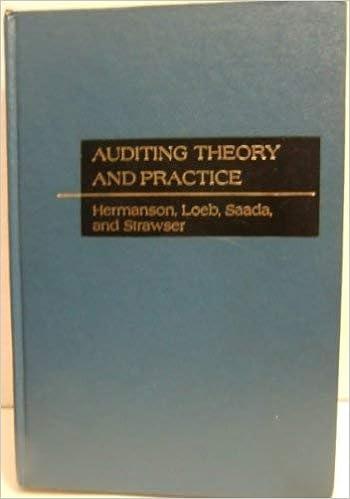Question
1. Which of the following is not likely to be a fixed cost? A. direct materials B. rent C. depreciation D. salary of the human
1. Which of the following is not likely to be a fixed cost?
A. direct materials B. rent C. depreciation D. salary of the human resources director
2. Costs incurred in the past which are not relevant to present decisions are
A. fixed costs.
B. sunk costs. C. opportunity costs. D. indirect costs.
3. Managerial accounting
A. is primarily directed at external users of accounting information. B. is required by taxing authorities such as the IRS. C. must follow GAAP. D. is optional.
4. Which of the following is most likely to make use of Spruce Companys managerial accounting information?
A. the IRS B. an individual contemplating an investment in Spruce Company C. a company that is one of Spruces main competitors D. the production manager of Spruces plant in Minnesota
5. Ice Box Company manufactures refrigerators. Which of the following items is most likely to be an indirect material cost for Ice Box Company?
A. Factory supervisors salary B. Lubricant for refrigerator door hinges C. Glass shelves for the refrigerators D. Refrigerator motors
6. Which of the following accounts does not appear on the balance sheet?
A. Raw Materials Inventory B. Finished Goods Inventory C. Work in Process Inventory D. Cost of Goods Manufactured
7. Which of the following lists presents the accounts in the order in which product costs flow?
A. Raw Materials Inventory, Finished Goods Inventory, Work in Process Inventory, Cost of Goods Sold B. Cost of Goods Sold, Work in Process Inventory, Raw Materials Inventory, Finished Goods Inventory C. Raw Materials Inventory, Work in Process Inventory, Finished Goods Inventory, Cost of Goods Sold D. Work in Process Inventory, Finished Goods Inventory, Cost of Goods Sold, Raw Materials Inventory
8. The balance in the Finished Goods Inventory account on July 1, 2007, was $34,000 and the June 30, 2008, balance in the Finished Goods Inventory account was $41,000. If the cost of goods manufactured was $200,000, what was the cost of goods sold?
A. $285,000 B. $193,000 C. $207,000 D. $278,000
9. Which of the following describes the differences between job-order and process costing?
A. Job-order costing is used in financial accounting while process costing is used in managerial accounting. B. Job-order costing can only be used by manufacturers; service enterprises must use process costing. C. Job-order costing is voluntary while process costing is mandatory. D. Job-order costing traces costs to jobs while process costing traces costs to departments and averages the costs among the units worked on during the period.
10. Which of the following costs is not added to the Work in Process account in a process costing system?
A. manufacturing overhead B. direct materials C. direct labor D. advertising
Step by Step Solution
There are 3 Steps involved in it
Step: 1

Get Instant Access to Expert-Tailored Solutions
See step-by-step solutions with expert insights and AI powered tools for academic success
Step: 2

Step: 3

Ace Your Homework with AI
Get the answers you need in no time with our AI-driven, step-by-step assistance
Get Started


